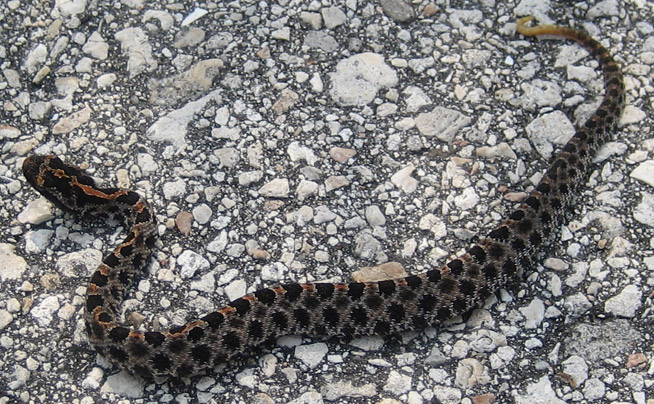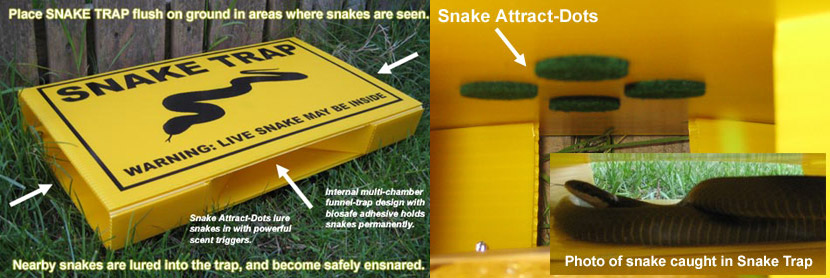
Biology:
The pigmy rattlesnake (sistrurus miliarius) is a venomous snake that is native to the southeastern continental United States. Pigmy rattlesnakes also go under the names spottled rattler, spotted rattlesnake, pigmy ground rattlesnake, ground rattler, grey rattlesnake, bastard rattlesnake, southern rattlesnake, dwarf rattlesnake and small rattlesnake.
The pigmy rattlesnake is considered a subspecies of pitviper. Like all pitvipers, pigmy rattlesnakes produce a weak venom. The “pit” in the name pitviper refers to a specialized organ in the snake’s head that can detect the heat generated from other living animals.
As the name would suggest, pigmy rattlesnakes tend to be smaller than most other rattlesnakes. Typically, an adult will be a bit over half a meter in length and males and females are usually about the same size. This means that pigmy rattlesnakes lack the sexual dimorphism that is common in most animals and snakes.
This species of snake often has a greyish-blue coloration with red and black markings along the top and side of the body. The end of the tail tends to have a yellowish coloration and the head is mostly black and silver. However, since there are three subspecies of pigmy rattlesnake with many local varieties a general description is impossible to give.
Habitat:
This snake lives in the southeastern United States. Pigmy rattlesnakes are known to live in South Carolina, North Carolina, Georgia, Missouri, Arkansas, Tennessee, Kentucky, Alabama, Florida, Mississippi, Texas, Oklahoma and Louisiana. The majority probably live in Florida among hardwood hammocks and other woodland ecosystems. The pigmy rattlesnake prefers to live in wood areas and frequently lives around marshes or other water bodies like rivers or lakes.
Behaviour:
Like other pitvipers, the pigmy rattlesnake is a nocturnal animal. This means that it is usually the most active during the hours after the sun has set at night.
Like other rattlesnakes, the pigmy rattlesnake will shake its tail when threatened to ward off potential predators or other dangers. However, because of its very small size for a rattlesnake the tail rattle does not make a very loud noise. This means that pigmy rattlesnakes are especially dangerous because a person can be nearly on top of one before they realize they are about to step on the snake.
Pigmy rattlesnakes are also known to be exceptionally aggressive towards humans. When one feels threatened it can bite a human multiple times, delivering a small amount of venom. If this occurs it is very important to get to a hospital immediately. It should be noted that the venom produced by pigmy rattlesnakes is typically not enough to kill a human, but it should still be taken seriously. People should avoid trying to handle or trap a pigmy rattlesnake themselves. The venom produced by pigmy rattlesnakes causes intense bleeding at the site of the wound, and the pigmy rattlesnake bite is the most common cause of snake envenomation in many areas.
In the warmer months a pigmy rattlesnake might spend its days sunning itself on a rock and its nights hunting for its prey. During the colder months this species may hibernate in a burrow with other pigmy rattlesnakes to keep warm.
Generally pigmy rattlesnakes are very shy and will try to avoid being disturbed by other animals. They prefer to hide in leafs or bark. They are even known to use the burrows of gopher tortoises as homes.
Diet:
The pigmy rattlesnake is a carnivore, like all other snakes. This means that the pigmy rattlesnake eats meat and does not eat plants. It uses its venom to subdue prey. The prey of a pigmy rattlesnake consists of many different kinds of animals, including mice, small rates, small squirrels, birds, and other reptiles including lizards, frogs, toads and other snakes. Sometimes they will go after insects as well. Pigmy rattlesnakes hunt by trying to catch prey off guard.
Like other snakes, pigmy rattlesnakes are very important to their local ecosystems because they help maintain the natural balance of different animal species. Despite their ferocious reputation, these snakes deserve protection for this reason.
Reproductive:
Pigmy rattlesnakes are ovoviparous like most other pitvipers. This means that they give birth to live young rather than laying eggs which hatch months later. Usually the female gives birth to between five and eight younglings.
Young pigmy rattlesnakes look slightly different from their adult counterparts. Usually their coloration is of a lighter hue than adults.
Many people want to know how to kill a Pigmy Rattlesnake, but you don't need to. The
best way to get rid of Pigmy Rattlesnakes is to simply leave them alone. You can also
use a Pigmy Rattlesnake trap to catch them - that's one of the best ways for how to
remove Pigmy Rattlesnake. For more information, go to my
Snake Removal - How to Get Rid of Snakes home page.
If you need Pigmy Rattlesnake removal in your city, I have friends that I have
personally trained in these cities:
Option 1 - HIRE A PROFESSIONAL
We can solve your snake problem for you. Our nationwide group of snake specialists services 95% of the US population. Click here to find your local snake removal expert in your town. Below are just some of our more popular areas:Option 2 - BUY A SNAKE TRAP
If a snake is indoors, a trap will work. I do not recommend using a glue-based trap outdoors, because it can inhumanely catch other small critters. I have reviewed and field tested several snake trap designs, and the one featured below is the most durable and effective. It is the highest quality snake trap available on the market. Read more about Snake Trap.
For more information, go to my Snake Removal - How to Get Rid of Snakes home page.